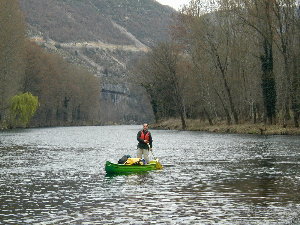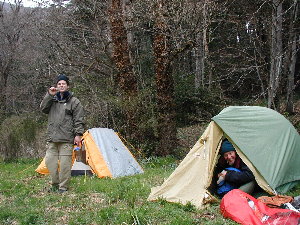 Adventures
Adventures 
[Home] [Adventures] [Free Advice] [Links]
Les Gorges Du Tarn, |
 |
Reeling from a 6-hour jet lag followed by 4 hours of sleep the next night, I make a mistake reading the map that cost us at least three hours of driving time. We head for St. Etienne instead of St. Enimie. We call François and let him know we'll be late. "Ou la la!" he says. But no matter, we're still on, though the put-in will be at 15H (3 PM) instead of 10 or 11. François greeted us in the unlit doorway of his ancient stone outbuilding, wielding a ring of large iron keys. I immediately like him, his ageless eyes looking out from a creased and bearded face. He speaks almost no English but is used to getting his point across. We have selected the 72 km trip, the longest one offered and usually not until much later in the season.
 |
The price was extremely reasonable. At 18 euros a day (under 20 bucks), it was far cheaper than anywhere else. The price not only included bateaux, paddles, life vests, waterproof barrels and wetsuits if desired (we brought out own), it included a shuttle to the put-in at Ispagnac, one from the take-out at Aguessac, and a motor-portage around Pas de Souci, which I interpreted as "no worries", but Amy pointed out could mean "threshold of fear". You might ask a goldfish after it'd been flushed down the toilet what it would be like to run that stretch. It was a total boulder sieve. In real canoes, we could have easily portaged the ½ kilometer ourselves, but that friggin rental would have required rolling logs and winches so the motor portage was well appreciated.
 |
 |
Afloat at last! I don't remember much of the scenery from those first few hours; I am preoccupied with making this barge respond as we drop through multiple class II drops with some bordering on class III. We make a poor showing as my frazzled brain tries to apply normal paddling technique. Had I been used to paddling a submerged log, I would have been better off. Trying to turn the boat by stern sweeps largely results in just going faster in a straight line. Within the first two hours of the trip, we enter a class II-III rapid. It starts as a wave train that curves to the right, then spills into a mid-river rock, which must be passed on the right. Carp goes first, flitting around in that little mosquito of a craft and turns to wait below. Following his line, we try to cross over to the right, ride the current next to the wave train and safely avoid the rock. No dice, we can't get over far enough and we hit the wave train. Water pours in over the low gunwales, filling Amy's compartment first, then the middle compartment second. My third compartment stays pretty clear of water. The hollow construction of the boat provides plenty of flotation, but all down low and the boat wallows to one side then the other. Of course, we wash right into the rock and spill. Ice cold water, I am very happy to have my wetsuit on. I shout at Amy to swim clear of the boat while I grab hold of the rear toggle. She swims over to Carp, who has already rescued the dry bag and he paddles her ashore while I swim to shore with the boat. He goes out again and gets a loose water bottle. All told, we lost a length of rope and a chapstick from my pocket. It's late in the day; leaden skies and we just took a cold swim. Sean swings into action again and fires up the stove for some cocoa and presses some warm dry fleece onto Amy. I am glad that he knows just what to do and doesn't mind parting with some dry clothes. We're soon back on the river but I'm still feeling chilled and ask that we start looking for a campsite. Not a bad idea anyway, since it will be dark in about two hours.
 |
Now "wild" camping is prohibited on the Tarn as well as most places in France. Some really good news that was disguised as bad news was the fact that we were paddling off-season. This meant that the public campgrounds were all closed. Therefore, we were required to camp anywhere we darn well wanted. Of course, being off-season also meant we were the only ones on the river. Such a shame.
We found a nice sandy beach for our campfire, with flat, level grassy shelf up in the trees for the tents. Perfect. We couldn't ask for better. Nothing like cooking over a campfire to soothe the spirits. It began to soak in that we were doing the impossible, wilderness camping in Europe on a remote stretch of a beautiful class II river.
After a long and well deserved sleep, the new day finds us refreshed and eager to paddle, though the start was none too early. Daylight and a clear mind allow me to appreciate my surroundings for the first time. The valley and gorge have a dreamlike quality. The rocks were the same as home, the waves and lines of passage were too. But to descend such a mild river between the enclosing ramparts and towering spires of the gorge were incredible. The vertical cliffs hemmed in the steep talus slopes leading to the river's edge.
 |
 |
Reading rapids, making miles and watching history scroll by made for a surreal four days on the river. I could imagine our campsites on sand bars were the same ones that wandering traders used when approaching the strongholds. Footprints in the sand still reveal what kind of game was available. Strange cleft-hoofed tracks makes us think of feral pigs. Hairy looking vines on the trees makes me recoil, thinking of poison ivy, but it’s just English ivy.
Stone. Everything is made of stone. Bridges, houses, roofs. Walls, wells, walkways. And all native. It is impossible to tell where the blocky sedimentary bedrock outcrops leave off and the house walls begin. The buildings seem to have sprouted there on their own.
 |
More:
Tarn Info
Peter's Report on the Dordogne, another great river in France: Dordogne
François Boulot's site: Canoë-Canyon